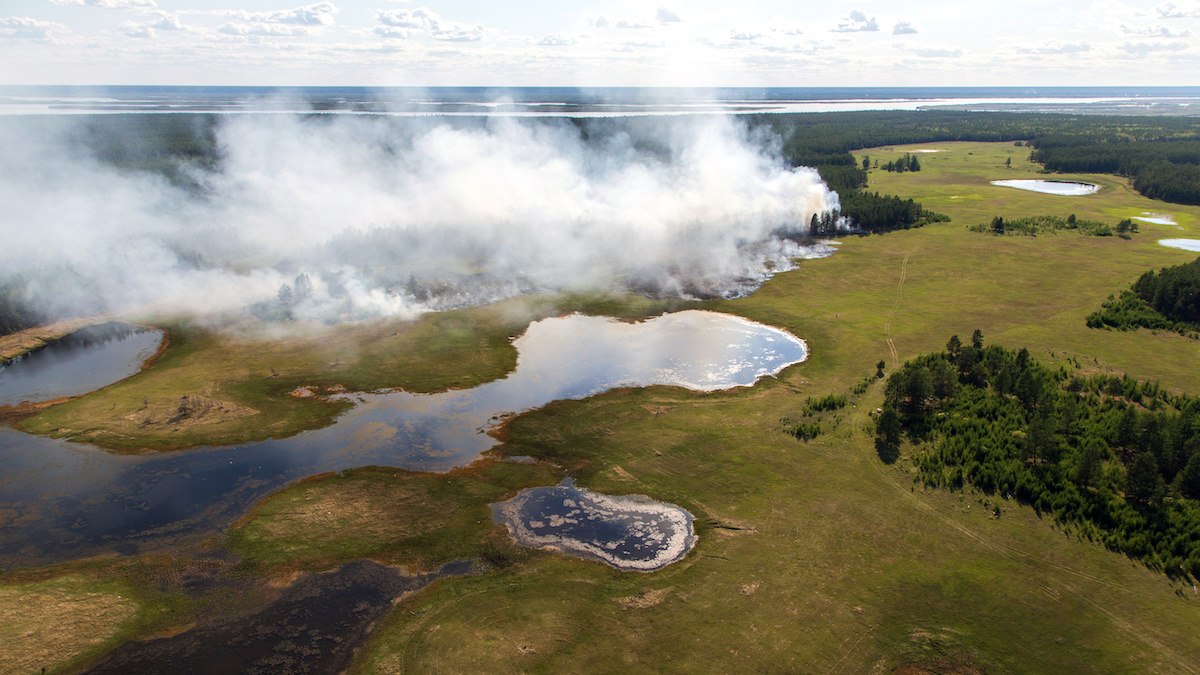
The Arctic Is on Fire and Warming Twice as Fast as the Rest of the Earth

A forest fire in Yakutsk in eastern Siberia on June 2, 2020. Yevgeny Sofroneyev / TASS via Getty Images
Once thought too frozen to burn, Siberia is now on fire and spewing carbon after enduring its warmest June ever, according to CNN.
The most immediate impacts of the climate crisis are in the nether-regions world of the world where temperatures are extreme and inhospitable. One of the most alarming examples is playing out in Siberia, which just saw temperatures reach triple digits as it endured its warmest month ever. That June heatwave in Siberia has led to some staggering numbers, according to scientists, as CNN reported.
The wildfires in Siberia started much earlier in the spring than ever before, according to The Washington Post. Permafrost is thawing, infrastructure is crumbling, and sea ice is dramatically vanishing.
“We always expected the Arctic to change faster than the rest of the globe,” said Walt Meier, a senior research scientist at the National Snow and Ice Data Center at the University of Colorado at Boulder, to The Washington Post. “But I don’t think anyone expected the changes to happen as fast as we are seeing them happen.”
The wildfires released an estimated 59 megatonnes of carbon dioxide across Siberia in June, according to scientists at the Copernicus Atmosphere Monitoring Service (CAMS). This spate of fires on landscapes that are typically too cold, wet, and icy to burn is raising alarms for ecologists and climate scientists, according to National Geographic. They fear the rash of blazes is another sign that the Arctic is undergoing rapid changes that could set off a series of consequences on a global scale.
The fires can be a double whammy for the Siberian ecosystem. If they become a regular occurrence, it could cause new species to colonize the area, which would set the stage for more fires. Also, the increased intensity and duration of the fires may accelerate the climate crisis by thawing the ground and releasing trapped carbon that has accumulated in frozen organic matter, as National Geographic reported.
“By how big they are and how hot they are, I would say there’s no way they’re not burning down,” said Amber Soja, an associate research fellow with the National Institute of Aerospace and an expert on Siberian wildfires, to National Geographic.
Already, the area’s carbon dioxide emissions for June were its highest in the 18 years of the CAMS dataset, surpassing the record of 53 megatonnes set just one year ago in June 2019.
“Higher temperatures and drier surface conditions are providing ideal conditions for these fires to burn and to persist for so long over such a large area,” said CAMS senior scientist Mark Parrington, as CNN reported.
“We have seen very similar patterns in the fire activity and soil moisture anomalies across the region in our fire monitoring activities over the last few years.”
Siberia also had a warmer than average winter. CAMS said that the warm winter meant that “zombie” blazes were able to smolder through the winter and may have reignited this spring, according to Phys.org.
Globally, June 2020 was more than half a degree Celsius warmer than the 1981-2010 average for the same month, and on a par with June 2019 as the warmest ever registered. Siberia, which is larger than the U.S. and Mexico combined, was more than 5 degrees Celsius above normal for June, according to Copernicus Climate Change Services satellite data, as Phys.org reported.
Some parts of Siberia had an average temperature that was 10 degrees Celsius, or 18 degrees Fahrenheit, warmer than average. The Arctic is warming twice as fast as the rest of the planet through a process known as Arctic amplification, as CNN reported. Arctic ice melt has accelerated, which leads to seasonal snow cover that isn’t as white and absorbs more sunlight, which leads to more warming, according to the National Oceanic and Atmospheric Administration.
“To me what’s really shocking is how warm it’s been relative to average for so many weeks and months,” said Zack Labe, a climate scientist at Colorado State University, as National Geographic reported.
- Zombie Fires Could Be Awakening in the Arctic - EcoWatch
- Siberian Forest Fires Increase Fivefold in Week Since Record High ...
- Rewilding the Arctic Could Slow the Climate Crisis - EcoWatch
- 550,000 Acres on Fire in Alaska in Latest Sign of the Climate Crisis ...
- 'Unprecedented' Wildfires in Arctic Have Scientists Concerned ...
- Siberian Heat Wave Was Made 600x More Likely by the Climate Crisis, Scientists Say - EcoWatch
- Reindeer and Their Nomadic Herders Face Climate Change - EcoWatch
- Arctic Wildfires Are Changing, With Big Implications for the Global Climate - EcoWatch

 233k
233k  41k
41k  Subscribe
Subscribe 